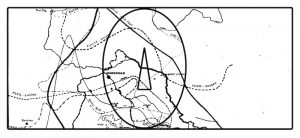INTERPRT
Race and Forest
March 6–April 19, 2020
Lecture by Nabil Ahmed: March 7, 5–7pm
Guided tour by Nabil Ahmed: March 8, 12–1pm
Guided tour by Filip Wesołowski: March 15, 12–1pm
Guided tour by Sebastian Cichocki: April 15, 6–7pm
Discussions concerning the climate disaster more and more frequently mention the necessity to acknowledge ecocide as a crime in the light of international law. One of the first ever examples of charges where the environment became the main subject of court proceedings was a case presented by Polish prosecutors, concerning the destruction of Polish forests by Nazi Germany. Race and Forest, the exhibition shown at Biennale Warszawa reconstructs the circumstances of this precedential indictment.
Race and Forest investigates the links between genocide, ecocide and forest management. The exhibition was prepared by an interdisciplinary research team INTERPRT which collects facts related to the crimes against the natural environment. It devotes particular attention to points where international humanitarian law intersects the legal protection of the environment. Re-entwining images, documents, testimonies and data from various sources, it creates a framework for new reflection. The project displayed at Biennale Warszawa examines the material and visual nature of the evidence in the case no. 1307.
Its history dates back to 1947, when as part of the United Nations War Crimes Commission (UNWCC), Poland brought against 11 German citizens charges of war crimes related to the destruction of the natural environment. Polish prosecutors prepared a bill of indictment not only for high ranking German state officials, but also the employees of German forestry departments. The trial concerned deliberate devastation of Polish forests in order to supply timber for German war efforts. At the same time Germany was developing modern forestry and taking considerable measures to conserve their own forests.
Part of the exhibition is devoted to the history of a Nazi death camp located near Chełmno nad Nerem (Kulmhof). In the first period of the operation of the camp—hidden in the Rzuchowski Forest—a secret reforestation plan was implemented in order to hide the evidence of mass graves. The investigative project carried out by INTERPRT in cooperation with Biennale Warszawa combines archival and cartographic research with wartime testimonies and LIDAR scanning to conduct a new spatial analysis of this area.
The exhibition will also feature materials concerning how were the race issue and environmental issues connected in the Third Reich ideology. Among them, Wald und Holzer (forest and timber), a periodical which during the Second World War was the official gazette of the forestry industry in the German-occupied areas. The data collected in it were supposed to help in effective exploitation of Polish forests. The paper propagated the ideology of environmental racism, according to which Germanic and Nordic people were to protect nature against the designs of savage Slavic peoples.
By analysing the history of genocide in the context of nature, Race and Forest includes the study of the Holocaust into the current deliberations about climate change and human responsibility for the environment. Can the case no. 1307 become a basis for considering nature as a legal entity? How to extend legal protection also to non-human beings, animals, or ecosystems?
Taking up the topic of crimes related to the environment requires a comprehensive view—not only new formulas of thinking, but also acting. When designing the communication for Race and Forest we wanted to reduce the environmental impact of our actions to a minimum. We have made only a single copy of a leaflet for our visitors to pass around, and a single poster exhibited for a limited time in various places. While reducing the industrial manufacturing of materials, we want the Internet to be the main source of information about the exhibition, and knowledge about it to travel by word of mouth and to be handed around. Pass it on.
Curator: Bartosz Frąckowiak
Exhibition concept: INTERPRT / Team:
Art direction and texts: Nabil Ahmed
Exhibition design: Olga Lucko, Phil Buckingham
Lidar data analysis and 3D visualization: Alican Akturk
Geographic information system: Joel Koupermann
Archival research, Subject-matter cooperation: Filip Wesołowski
Visual identification: Jakub de Barbaro


